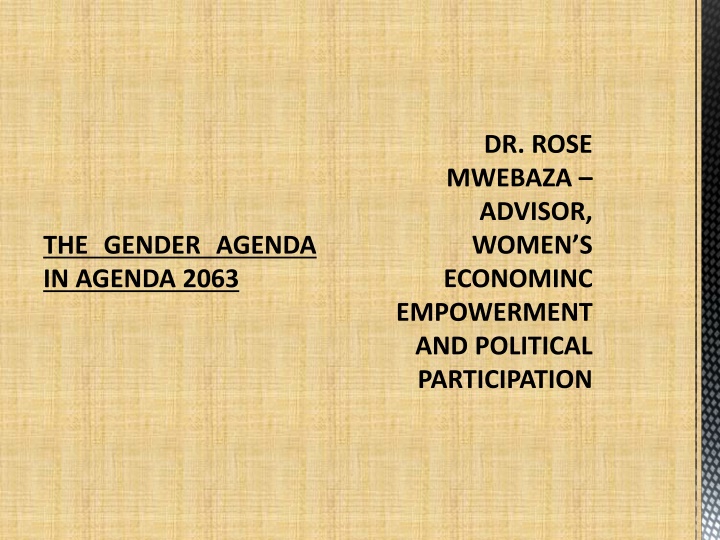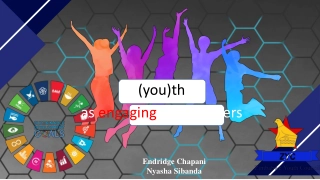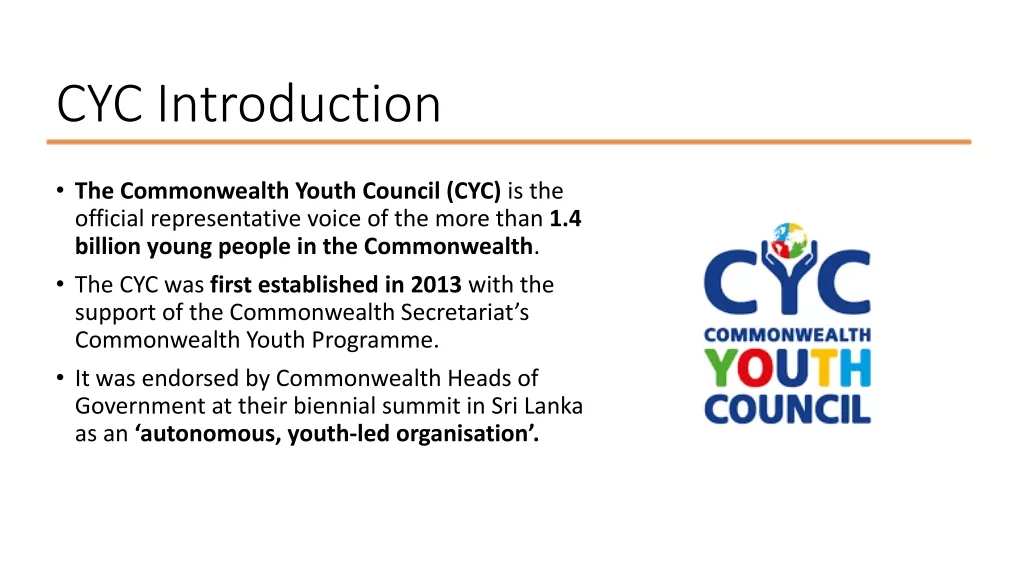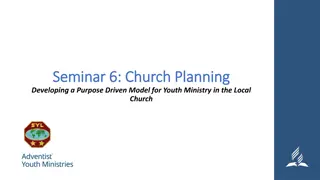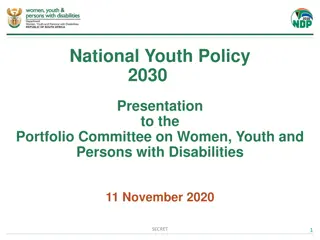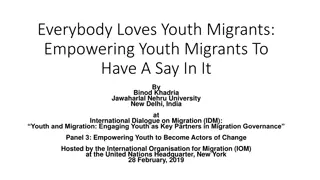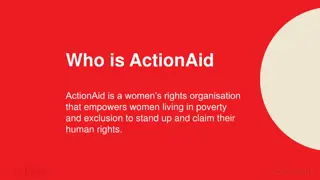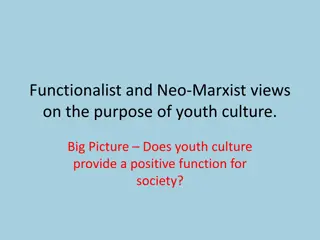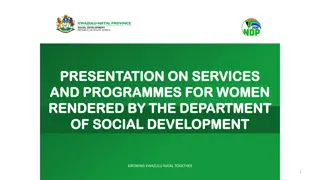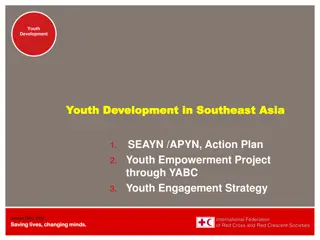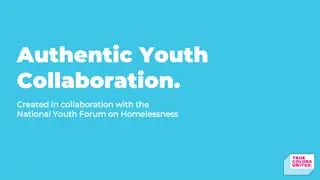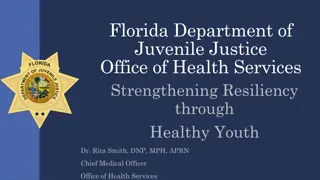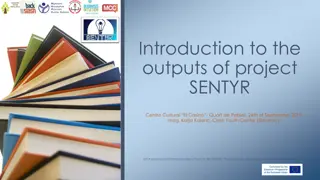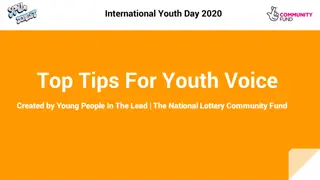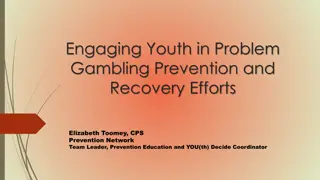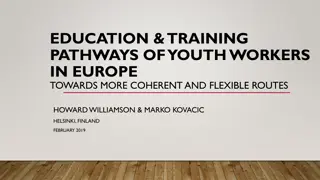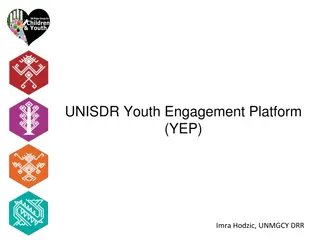Empowering Women and Youth in Agenda 2063
The vision of Africa in Agenda 2063 emphasizes gender equality, empowerment of women and youth, and elimination of discrimination. By 2063, all forms of violence and barriers hindering women's progress would be eradicated. The goal is to achieve full gender parity, with women holding 50% of elected offices and managerial positions. The agenda also focuses on empowering African children and youth through education, training, and economic opportunities. Empowering women and youth is essential for Africa's development and prosperity.
Download Presentation

Please find below an Image/Link to download the presentation.
The content on the website is provided AS IS for your information and personal use only. It may not be sold, licensed, or shared on other websites without obtaining consent from the author.If you encounter any issues during the download, it is possible that the publisher has removed the file from their server.
You are allowed to download the files provided on this website for personal or commercial use, subject to the condition that they are used lawfully. All files are the property of their respective owners.
The content on the website is provided AS IS for your information and personal use only. It may not be sold, licensed, or shared on other websites without obtaining consent from the author.
E N D
Presentation Transcript
DR. ROSE MWEBAZA ADVISOR, WOMEN S ECONOMINC EMPOWERMENT AND POLITICAL PARTICIPATION THE GENDER AGENDA IN AGENDA 2063
The vision of Africa expressed in Agenda 2063 is one of an Africa whose development is people- driven, especially relying on the potential offered by its women and youth; Under this vision, it is envisaged that there will be gender equality in all spheres of life and an engaged and empowered youth THE GENDER AGENDA IN AGENDA 2063
Gender Equality: 1. By 2063, all forms of violence and discrimination (social, economic, political) against women and girls would have been eliminated and they would fully enjoy all their human rights. This means an end to all harmful social practices and that all barriers to access to quality health and education for women and girls would be non-existent. 2. The Africa of 2063 would see fully empowered women with equal access and opportunity in all spheres of life. This means that the African woman would have equal economic rights, including the rights to own and inherit property, sign a contract, register and manage a business. Over 90% of rural women would have access to productive assets, including land, credit, inputs and financial services. 3. The Africa of 2063 would see attainment of full gender parity. It would see women occupy 50% of elected offices at state, regional and local bodies, and 50% of managerial positions in government and private sector would be women.. The economic and political hindering women s progress would finally have been broken. THE GENDER AGENDA KEY COMPONENTS glass ceiling
1. By 2063, African children and youth would be fully empowered starting with full implementation African Charter on the Rights of the Child. Youth overt unemployment would have been eliminated and they would have full access training opportunities, services, recreational and cultural activities as well as to financial means to allow each youth realize their full potential. The youth will be progenitors of new knowledge driven business start-ups and will contribute significantly to the economy. All forms of illegal migrations of youth would have ended, with travels to the outside world undertaken mainly for cultural and recreational purposes and not as a search for opportunities. The talent of African youth would be finally be used fully to foster the continent s political, social, cultural and economic development. of the 2. to educational health EMPOWERED AND ENGAGED 3. YOUTH 4. 5.
Women: The women bear in poverty, illiteracy and disease. Women are 52 per cent of population , but they have unequal access to economic, political, social and cultural opportunities. Many countries have legal frameworks guaranteeing seats Parliament; 10 countries in Africa have achieved the 30% target representation in Parliament and the process is continuing. Africa is addressing the gender gap in Primary Education However, the continent is below the average for the group of LDC s. Gender parity at secondary and tertiary levels is however less promising, though women s enrolment at the tertiary level is growing faster than men. The advancement of women s rights in Africa has been demonstrated through the high ratification of the CEDAW Protocol; to date, 36 Member States of the AU have ratified it. disproportionate burden African THE the CHALLENGES OF GENDER EQUALITY AND YOUTH EMPOWERM ENT IN AFRICA for women in for women
Majority of women are employed in agriculture where productivity and incomes are low. Many of those employed agriculture are in the informal sector where jobs are vulnerable and incomes low wage disparities. The inadequate commitment pronouncements on restoration of gender inequalities with respect to access, participation advancement of deeds THE CHALLENGES OF GENDER EQUALITY AND YOUTH EMPOWERM ENT IN AFRICA outside with gender political match to and with women
Africa has a very youthful population. In 2010 there were 364 million Africans aged 15 34 years and 209 million aged 15 24 years. These accounted for 35.6 per cent and 20.2 per cent of the population, respectively. Education: Inadequate especially at the secondary and tertiary levels Employment: Estimates put youth unemployment at under 5 per cent for Malawi and Rwanda, above 20 per cent in Ghana, Zambia and Zimbabwe and over 30 per cent in Mauritius, Botswana, Namibia, Swaziland, South Africa (Regional Overview: Youth in Africa, UN 2011. Health: The youth are the most affected by the three major diseases HIV/AIDS, Malaria and Tuberculosis. total African access YOUTH Lesotho, Algeria and
Emerging challenges of alcoholism and illicit drugs have induced the recorded cases of youth with mental disorders, disabilities and accidents amongst others. Poverty: Poverty among youth is very high and it is estimated that 71% live below 2USD a day. Violence and Conflict: The youth bulge presents myriad reasons for concern given indications of a strong correlation countries prone to civil conflict and those with burgeoning populations YOUTH between youth
AGENDA 2063 GOALS, PRIORITY AREAS & STRATEGIES
Goal 14: Full gender equality in all spheres of life To attain this goal, African countries would have to address the following priority areas and indicative strategies: Empowered women and girls and provide equal access and opportunity in all spheres of life End all forms of violence and discrimination (social, economic and political) against women and girls and ensure full enjoyment of all their human rights Priority Area Indicative Strategies Develop / promote polices that will enhance access to productive assets (including financing) by women and the youth Develop / implement mechanisms for tracking progress towards parity by women with respect to access to productive assets/skills, participation in all levels of governance and advancement in positions within the public and private sectors Empowered women and girls and provide equal access and opportunity in all spheres of life Develop / implement national strategy for the promotion of the rights of women, youth, children, the vulnerable, the marginalized, the physically challenged Ensure that education systems provide the young generation with quality education that imparts key generic competencies, skills and attitudes that lead to a culture of lifelong learning and entrepreneurship. Promote skills acquisition through competency-based training for employment, sustainable livelihoods and responsible citizenship. Eliminate gender disparities and ensure gender equality, girls and women s empowerment throughout the education system. End violence discrimination (social, economic and political) women and girls and ensure enjoyment of all their human rights all forms of and against full
AGENDA 2063 GOALS, PRIORITY AREAS & STRATEGIES Goal 15: Engaged and Empowered Youth To attain this goal, African countries would have to address the following priority areas and indicative strategies: Empowered children and youth with access and opportunity in all spheres of life, especially education, health and employment Priority Area Indicative Strategies Create youth skills development and employment programmes Promote the growth of youth businesses / start ups Empowered Youth and Children with access opportunity in all spheres especially education, and employment and of life, health
The enablers for Agenda 2063 include equality and participation of youth and women. gender AGENDA 2063 GOALS, PRIORITY AREAS & STRATEGIES The Result Framework for Agenda 2063 provides indicators for the Gender and Youth goals. also detailed
RESULTS FRAMEWORK FOR AGENDA 2063 - WOMEN Goal 15. Full gender equality in all spheres of life Priority Areas for 2063 6.1.2. Empowered women and girls and provide equal access and opportunity in all spheres of life Targets 1. Equal economic rights for women, including the rights to own and inherit property, sign a contract, register and manage a business and own and operate a bank account by 2025 Ensure 90% of rural women have access to productive assets, including land, credit, inputs and financial services by 2030 50% of all elected officials at local, regional and national levels are women 2030 At least 50% of management positions in government and private sector are held by women by 2030 Reduce to zero all acts of violence against women and girls in all settings (private, public as well as in conflict situations) End all harmful social norms and customary practices against women and girls and those that promote violence and discrimination against women and girls by 2030 Eliminate all barriers to quality education, health and social services for women and girls by 2020 End all forms of political, social, economic, legal or administrative discrimination against women by 2020 2. 3. 4. 6.1.1. End all forms of violence and discrimination (social, economic and political) against women and girls and ensure full enjoyment of all their human rights 1. 2. 3. 4.
RESULTS FRAMEWORK FOR AGENDA 2063 - YOUTH 6.2.1 . Empowered youth and children with access and opportunity in all spheres of life, especially education, health and employment 1. Reduce youth unemployment by 25% in 2020; by 50% in 2025 and by 90% in 2050 Youth business start ups in all business start ups is: 15% by 2020; 25% in 2030 and 35% in 2063 Eliminate all forms of illegal migrations of youth by 2025 All youth have access to educational and training opportunities, heath services and recreational and cultural activities by 2030 At least double proportion of Youth representation in political office at all levels local, regional and national levels by 2035 Full implementation of the provisions of the African Charter on the Rights of the Child by 2025 End all forms of violence against children by 2020 End all forms of exploitative child labour by 2020 End the phenomena of recruitment of child soldiers by 2020 Engaged and empowe red Youth 2. 3. 4. 5. 6. 7. 8. 9.
- PARTICIPATION AND WOMEN LEADERSHIP IMPLEMENTATION OF AGENDA 2063 - FLAGSHIP PROGRAMMES GIRLS AND YOUNG WOMEN
